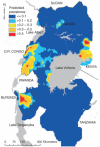Spatial co-distribution of neglected tropical diseases in the east African great lakes region: revisiting the justification for integrated control
- PMID: 20409287
- PMCID: PMC2875158
- DOI: 10.1111/j.1365-3156.2009.02440.x
Spatial co-distribution of neglected tropical diseases in the east African great lakes region: revisiting the justification for integrated control
Abstract
Objective: To determine spatial patterns of co-endemicity of schistosomiasis mansoni and the soil-transmitted helminths (STHs) Ascaris lumbricoides, Trichuris trichiura and hookworm in the Great Lakes region of East Africa, to help plan integrated neglected tropical disease programmes in this region.
Method: Parasitological surveys were conducted in Uganda, Tanzania, Kenya and Burundi in 28 213 children in 404 schools. Bayesian geostatistical models were used to interpolate prevalence of these infections across the study area. Interpolated prevalence maps were overlaid to determine areas of co-endemicity.
Results: In the Great Lakes region, prevalence was 18.1% for Schistosoma mansoni, 50.0% for hookworm, 6.8% for A. lumbricoides and 6.8% for T. trichiura. Hookworm infection was ubiquitous, whereas S. mansoni, A. lumbricoides and T. trichiura were highly focal. Most areas were endemic (prevalence >or=10%) or hyperendemic (prevalence >or=50%) for one or more STHs, whereas endemic areas for schistosomiasis mansoni were restricted to foci adjacent large perennial water bodies.
Conclusion: Because of the ubiquity of hookworm, treatment programmes are required for STH throughout the region but efficient schistosomiasis control should only be targeted at limited high-risk areas. Therefore, integration of schistosomiasis with STH control is only indicated in limited foci in East Africa.
Figures






Comment in
-
Towards defining appropriate strategies for targeted NTD control.Trop Med Int Health. 2010 Jun;15(6):772-3. doi: 10.1111/j.1365-3156.2010.02522.x. Epub 2010 Apr 14. Trop Med Int Health. 2010. PMID: 20406429 No abstract available.
References
Publication types
MeSH terms
Grants and funding
LinkOut - more resources
Full Text Sources

